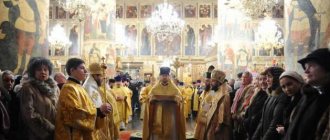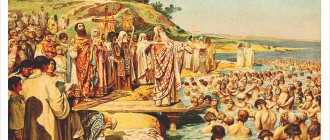In this article we will look at the difference between religion and faith.
Faith is the willingness to accept something without evidence. On the other hand, it is confidence in luck without any guarantees. The hope that the object of belief will help us. What then is religion?
Religion is a connection with otherworldly forces. But conviction still includes belief, because it is pointless to establish a connection with something that you do not believe in. As in every activity, there are quite a lot of particulars in religion: from postulates to rules of behavior. Such activity can be maintained without faith, only then it will no longer be a religious activity. This is just a deception. Now let's look at faith and religion in more detail.
Faith - what is it?
Faith is an individual perception of something from a position of unproven acceptance . Faith refers not only to the spiritual side of life, but also to, for example, relationships. Believing another person means accepting information from him without requiring proof. In relationships, faith is called trust. Faith in a relationship with God means that we accept Him not from the position of reason, principles, dogmas and evidence, but from the position of the heart, that is, we accept Him into our hearts without any other thoughts. This is how we build a relationship with God. That is, faith, in a spiritual context, has the meaning of a subjective, personal perception of the Lord, from which certain relationships and unconditional acceptance of something are formed.
He who has faith will simply strive for the right life, doing things that seem right in spirit. But sometimes, excessive immersion in spiritual life, strong impressionability or weakness of mind , can prompt a person to commit extravagant acts based on an excessive impression of the relationship with God. Sometimes this reaches the point of fanaticism, radicalism, and sometimes even fundamentalism, that is, inflicting violence on others based on some internal feelings emanating from faith.
Also, faith can lead to fundamental errors of perception that cannot be understood without knowledge, instruction and experience. Such fundamental errors arise either from idealization, that is, the expectation of perfect behavior from everyone, in fact, subtle internal manipulation, or from one’s own fabrications, which arise from excessive internal absorption and lack of connection with reality.
For example, it may seem to a person that an elder is doing wrong and on the basis of this he begins to be prejudiced towards him. Although in fact, the elder can do the right thing, according to the instructions. But since the younger one, feeling strong spiritual experiences, begins to believe that everything that comes from within is correct, then his discontent will be perceived as the truth, although it may come from pride. Thus, faith can become a source of such perception in which everything from within is thoughtlessly accepted as truth. This results in an excuse for one’s own mistakes and an inability to show tolerance towards others. A duality appears that the person himself does not notice, believing that he is doing everything right, but at the same time having complaints against everyone.
Faith is an individual perception of something based on unconditional acceptance.
When a person believes in himself, he without evidence accepts himself as right and shows confidence. At the everyday level, sometimes this is good, sometimes it is bad. Faith in a person is the ability to accept his words and actions as truth without evidence. And we're not just talking about romantic relationships. For example, if a military leader has authority and the soldiers believe in him, then it is enough for him to say: “We will win” so that everyone believes in victory, despite all the arguments of logic. In relation to God and spiritual life, this is the ability to unselfishly accept the will of God and His instructions as the main priorities, even if this results in restrictions or suffering.
Religion - what is it?
Religion is a set of rules that prescribe a certain way of life, principles, laws, norms of behavior, prohibitions and permissions within the framework of which a person is able to know God. When it comes to religion, we talk about certain restrictions on behavior and regulations, according to which a person must engage in certain activities.
Thus, religion puts a person within a framework in which he is able to know God on the basis of compliance with moral and moral precepts. One should not assume that religion is “external” and that “God can only be known with the heart.” The fact is that the main goal of both religion and faith is the development of love for God. Faith personifies individual relationships, and religion represents the rules and regulations that God himself gave to man. When we talk about love for God, we should not start from the top and talk in terms of the brightest and highest manifestations of love, since at the initial and even average level of spiritual development this is quite hypocritical. How can we talk about love for God if a person does not even comply with the basic instructions coming from God himself?
We also recommend this article: Demonic qualities that enslave people. Qualities of demons.
Religious precepts, in general, are uniform and consist in observing moral precepts: moderation, humility, non-violence, theft, lies, and so on. Religious precepts in different religions are generally similar and correspond to the general spirit of the religion. Religion is the limiting factor that does not allow a person to fall, limiting his will exclusively within the framework beyond which lies the danger of the fall.
If the goal of faith and religion is the development of love for God, then religion at different levels personifies the development of relationships with God at the level of God’s faith in man himself. That is, if a person firmly and strictly observes religious principles, he deserves the trust of God and thus receives not only the ability to receive more benefits, since he is sufficiently developed within, but also a closer relationship with God.
Religion is a system of rules and regulations indicating prohibited, permitted and obligatory activities in spiritual life.
By following religion, a person develops sublime qualities in himself that make it possible to avoid the Fall at the level of a natural way of life. That is, by living a pure life, a sublime taste is cultivated, which pushes a person more and more toward spirituality .
Grace will stop sin
(Rom 3:24) Being justified freely by His grace through the redemption that is in Christ Jesus.
It plainly says that we have received justification for nothing. When we pray in the position of a righteous person, the Lord likes it, which means the sacrifice is not in vain. If we pray in the position of a sinner, then Christ’s sacrifice was in vain.
(James 2:17) Likewise, if faith does not have works, it is dead in itself.
Religion motivates Christians with this verse to achieve salvation by works. But don't unbelievers do this? They do. Maybe they do even better.
How to show faith? The same letter of James speaks of the deeds of Abraham and Rahab the harlot.
(Rom 4:2) If Abraham was justified by works, he has praise, but not before God.
Abraham was not justified by works, but by faith.
Contradiction? Of course not! Abraham was first justified by faith because he had done nothing for God. And even before Isaac was born, God made a covenant with Abraham. (Genesis 15:17-18) And works are a consequence of faith.
(Matthew 25:37-40) Then the righteous will answer Him: Lord! when did we see you hungry and feed you? or to the thirsty and gave them something to drink?
It says here that the righteous do not even know that they are doing good deeds. When we are in Christ, we don’t even notice how we help others, because it is part of our lifestyle.
(James 1:25) But whoever looks into the perfect law, [the law of] freedom, and continues in it, he, being not a forgetful listener, but a doer of the work, will be blessed in his action.
Abide in the Word of God, live the church life - this is proof of faith.
Water from a rock
(Numbers 20:1-3) And the children of Israel, the whole congregation, came into the wilderness of Sin in the first month, and the people stopped at Kadesh, and Miriam died there and was buried there. And there was no water for the congregation, and they gathered together against Moses and Aaron; and the people murmured against Moses and said: Oh, that we had died then, when our brothers died before the Lord!
Although 40 years had passed since the exit from Egypt, the people continued to grumble. God told Moses to take the rod and tell the rock to give water. But Moses disobeyed God and struck the rock twice. For this, Moses lost the opportunity to enter the promised land.
The Rock is Christ.
(Numbers 20-12) And the Lord said to Moses and Aaron: Because you did not believe Me, to show My holiness in the sight of the children of Israel, you will not bring this people into the land that I am giving them.
God did not allow Moses and Aaron into the Promised Land because they presented God differently from who He is. Therefore, it is very important to preach about grace, about the forgiveness of sins. Then we reveal Christ.
(John 1:17) For the law was given through Moses; grace and truth came through Jesus Christ.
What does this text mean? But here lies the answer to the question of why there are so many divisions in churches.
(Gal 4:22-26) For it is written: Abraham had two sons, one by a bondwoman, and the other by a freewoman. But he who is of a slave is born according to the flesh; and the one who is free, the one according to the promise. There is an allegory in this. These are two covenants: one from Mount Sinai, begetting into slavery, which is Hagar, for Hagar means Mount Sinai in Arabia and corresponds to the present Jerusalem, because he and his children are in slavery; and Jerusalem above is free: she is the mother of us all.
Law is Mount Sinai, and grace and truth are Zion. Hagar symbolizes the law, Sarah symbolizes grace. Although there is one father - Abraham, and different mothers. Some strive for law, others for grace. Most strive for law and grace at the same time, which is unacceptable.
(Acts 20:24) But I do not regard my life for anything, nor do I value my life, so long as I finish my race with joy and the ministry which I received from the Lord Jesus, to preach the gospel of the grace of God.
Gospel of God's grace. There is no other Gospel.
(Gal 1:6-8) I am amazed that you are so quickly moving from Him who called you by the grace of Christ to another gospel, which, however, is not another, but there are only people who are confusing you and want to change the gospel of Christ. But even if we or an angel from heaven were to preach to you a gospel different from what we preached to you, let him be anathema.
Paul defends the gospel of grace.
(Gal 5:4) You, who justify yourselves by the law, are left without Christ, you have fallen from grace,
Trying to justify yourself before God through your own efforts is called self-righteousness.
(Rom 10:3) For not understanding the righteousness of God, and seeking to establish their own righteousness, they did not submit to the righteousness of God: for the end of the law is Christ, unto the righteousness of everyone who believes.
It directly says that you cannot put your own righteousness against the righteousness of God. Separate law (self-righteousness, religion) from grace (the righteousness of Jesus Christ), and follow grace. The law condemns and leads a person into sin, and grace above the law stops sin.
Faith and religion - what is more important for a person?
Faith and religion are equivalent in spiritual life. It's like two wings. If you remove one thing, a fall occurs. If we take away faith, the taste for spiritual life is lost, the very meaning of observance and aspiration, sacrifice and constant stay in a spiritual state disappears. Having removed religion, we discover a disdainful attitude towards the laws of God, narcissism from which comes our own interpretation of certain truths. Sometimes, this comes to the point where persistent thoughts arise about one’s own holiness, and sometimes even divinity.
In our society, spiritual life is perceived very sentimentally. On the one hand, a person remembers God in moments of complete despair, but does not think about Him in joy. This is hypocrisy. On the other hand, believers tend to show signs of faith that are not ennobled by religion: they are overly radical and aggressive, and tend to transfer their ideals to others without following the instructions themselves. Most young atheists come from families in which religion was forced upon them, given the fact that the parents were not even adequate examples of the right side of religion.
Sentimentalism is also manifested in the fact that the thought of spiritual life is most often a thought of joy, sublimity and the absence of barriers. This forms a naive and childish basis for perceiving spiritual life as a way to avoid all the troubles and hardships of ordinary life. It is rarely possible to build monuments of any significance on such soil. Many people, starting a spiritual life, for various reasons, stop following it, on average, after 2-3 months. Most often this comes from disappointment , pride , laziness and lack of understanding of the essence of faith and religion.
We also recommend this article: Spirituality is the highest goal of the spiritual path.
How disappointment, pride and laziness destroy spiritual life
Disappointment is preceded by idealization: “ God is both kind and just , and will carry me in his arms, and I will simply enjoy.” Everyone who practices with me is perfect people and never makes mistakes, they were immediately born saints, and nothing bad will ever happen to me.” As practice progresses, ordinary tests of faith occur, which a person does not pass and ends the spiritual path with the same zeal with which he began it.
Laziness manifests itself in the fact that the spiritual path is perceived as a path lined with rose petals: walking along it is easy and pleasant, no adversity and no fence. The first months of spiritual practice usually look like this, as there is an intense spiritual experience that was not available before. As soon as this effect dissipates, and it always dissipates, a person discovers that books and sacred texts are boring to read, prayer is difficult, practicing spiritual life is difficult, and he puts everything off for later.
In fact, spiritual practice is the most difficult practice, because unlike material practice, it does not bear visible fruits that can be obviously associated with this practice. By playing sports we improve our body, by pursuing a career we improve our social and financial status, and spiritual practice leads to pure happiness. But at the same time, it is very difficult for an inexperienced eye to discern a direct connection between the process of spiritual practice and happiness itself. This, on the one hand, is obvious, but on the other hand, it’s just too lazy to sit down and force yourself to do something. You need to apply the will and develop taste and enthusiasm in yourself, and not rely on the eternal tailwind. By practicing sincerely and diligently, sooner or later a person will reach a level at which spiritual practice becomes not only spontaneous and natural, but also necessary. Then all the beauty will be revealed. But you should remember your humble position and then this level will be maintained.
Pride manifests itself in the childish: “I myself,” which develops into “I am a saint” or “I don’t need anyone but God, only He and I.” Sometimes this ends with a person proclaiming himself to be God and imagining himself to be extremely great. Most often, pride manifests itself in the fact that a person is not ready to rely on elders in his spiritual life. Tradition prescribes the presence of a mentor, an older person who answers questions, supports and helps in spiritual life. The absence of such a person creates an incorrect perception of spiritual life and relationship with God. Pride also manifests itself in the fact that after a certain level of practice, sooner or later, the thought arises that spirituality and sublime feelings do not come from God and spiritual practice, but simply come from the person himself. Due to this, a person often begins to believe that he does not need the advice of others and empowers himself to give advice to others. Which very quickly leads to a fall.
So, faith is a personal perception of God based on complete trust. Religion is a set of rules and regulations that allow one to live within a framework that limits the fall and separation from God. Faith is a path, and religion is a paved road, along which it becomes impossible to go astray. The ultimate goal of both religion and faith is love for God, and therefore it is important that faith and religion are not distracting, but supporting factors along this path. You shouldn't put anything above God.
Chapter 2. Components of religion and phenomena systemically related to it
Under esotericism
usually refers to teachings and rituals intended only for initiates and aimed at a clearly demarcated group.
The word "esotericism" comes from a Greek word meaning "from within." Close, but not identical concepts are “occultism” and “occult” (from the Latin occultus -
hidden).
Esotericism is associated primarily with ancient or primitive religions that have preserved the archaic way of religion (such as shamanic practices). In this case, he becomes closer to magic (see paragraph 1.4). However, this phenomenon is much broader, is not internally homogeneous in its origin and is widespread up to the present day.
Ancient magical cults implied the concealment of religious knowledge (primarily ritual formulas) in order to avoid competition and loss of authority. Sorcerers, healers and other adherents of magic maintained this practice much later, right up to the present day. Such knowledge was passed on dynastically, from older generations to younger ones. It is this type of esotericism that is most often meant when we talk about this phenomenon.
In addition, we can talk about a significantly different type of esotericism - “esotericism of the faithful,” the features of which are found in the Bible. In the Old Testament one can observe the principle that the worship of God involves a community of the faithful, chosen in the sense that they have known God and are thereby distinguished from others. The presence of a non-Christian could become, if not a profanation caused by the introduction into the temple of an unclean object or a person considered unclean, then a certain decrease in the holiness of the action taking place.
At the same time, in Old Testament Judaism, the separation of priests from the rest of the people during temple worship set the main goal of the presence before God of those worthy and specially designated to perform priestly functions, and not the usual desire to hide something from others in order to prevent them from taking advantage of it. Traces of such a perception of the relationship with God, arising from ideas about the absolute holiness of God, can be found in the New Testament (“do not throw pearls to swine,” i.e. do not waste sacred words talking to people who cannot listen to them with dignity and benefit ), in the communal and liturgical practice of early Christians. Such esotericism protected religion from the introduction of alien elements. This was especially important for Judaism, since it was a monotheistic religion surrounded by many polytheistic beliefs, and the temptation to introduce was often very strong.
For inclusion in the community of the chosen ones, special initiation rituals are intended
). They had to prepare a person for a change in his status, ensure the seriousness of his intentions and the preservation of the secret information received. Such procedures served as a sign of the importance of what was happening and therefore could be performed in an unusual solemn and even frightening atmosphere, in several stages. In this case, physical pain could be inflicted or certain signs could be applied to the body, marking a change in religious and social affiliation.
In the case of “esotericism of the faithful,” there are also initiation rituals, but they are of a significantly different nature. Their feature is openness, publicity of the commission and the absence of any mysterious knowledge transmitted at this moment. Purely theoretically, this knowledge can be available to everyone. Such procedures include rituals of entry into a religious community (circumcision as entry into a covenant with God in Judaism, baptism as entry into the church in Christianity) and inclusion in the clergy. In Christianity, the priesthood is understood not simply as permission to do something, but as the transfer of grace-filled power through the performance of the corresponding ritual (see chapters 5, 6). Possession of knowledge here is a condition for a dignified stay in a new state and therefore, most often, its acquisition precedes it. The complexity of this knowledge may give rise to an objective inability to master it, but is not the subject of concealment.
As Christianity spreads, and especially after its legalization and the transformation of most of the population into church members, the need to surround worship with mystery disappears. For example, penitents were not allowed into churches for purely disciplinary purposes. In this regard, Christianity and Judaism are religions devoid of esotericism in its typical understanding. Christianity insisted that believers know the basic principles of doctrine. The practice of limiting the reading of the Bible to the laity was dictated by the danger of misinterpretations due to insufficient literacy, on the one hand, and the high complexity of the text, on the other, and not by the desire to hide something. It was assumed that the correct interpretation was given by the priest, including during the service in the sermon. Likewise, the Christian Sacraments not only did not imply the concealment of anything, but their acceptance required special preparation with a detailed and comprehensive explanation of their essence. Entire works by church authors with similar teachings have been preserved. Because of the importance of the ritual, a person should be better prepared for it. What is taking place here is not esotericism, but rather a kind of “democracy” and the desire to expand the circle of knowledgeable, informed people, which is precisely incompatible with esotericism.
The revival of esotericism in Western Europe was observed with the beginning of the Renaissance (XIV century) and continued in modern times (from the 17th century). In Russia it became noticeable in the 17th–18th centuries, including due to the penetration of Freemasonry into the country. The Renaissance created fertile ground for the strengthening of esoteric trends due to increased interest in other cultures and the emergence of an elite consciousness among part of society, which was completely uncharacteristic of the Middle Ages.
Representatives of the educated, sophisticated, cultural layer of the small elite were cramped within the framework of “ordinary” religious ideas intended “for everyone.” This created an incentive to search for new elements and introduce them into traditional religion. Esoteric beliefs of the Neoplatonic type, especially the Gnostics, are beginning to gain popularity. The consciousness of one's intellectual superiority fed elitist demands and actually formed an elite that sometimes possessed some secret knowledge.
Often it was a type of magic. It was the Renaissance and the beginning of the New Age that gave rise to a surge in magical hobbies among the people, as evidenced by numerous court cases on charges of witchcraft and similar crimes. It should be noted that there really were attempts to practice primitive witchcraft magic in one form or another, and were not the figment of someone’s fevered imagination, as is sometimes commonly thought.
Thus, during this period there are two types of esotericism - popular and aristocratic. Within them we can conditionally distinguish non-religious and religious directions. Non-religious includes, for example, alchemy, which included many magical concepts.
Religious esotericism, with some degree of convention, can be divided into three types (although they are not always found in their pure form and can be combined). This:
– oppositional, disseminating views incompatible with the dominant religion;
– creating an unusual, unorthodox branch within a given religion;
- syncretic type, uniting different religious traditions.
Esotericism of the first type is most often represented by ordinary magic, the second is illustrated by Kabbalah in Judaism (see paragraph 6.1), the third is Martinism, Freemasonry, Theosophy.
Mixed types of religious esotericism include:
– yoga
(a complex set of contemplative practices combined with bodily exercises, genetically associated with Buddhism and some other religions of the East);
– tantrism,
especially modern (also combining a number of elements of Buddhism and Hinduism without a clear doctrine, but with a focus on improving and discovering new possibilities within oneself);
– sealing,
representing a complex of heterogeneous views dating back to antiquity, and combining the search for inner perfection with attempts to master the secret forces of nature in order to subjugate them. Due to some closeness of Hermeticism to scientific research, some scientists and philosophers were also interested in it.
Usually, the leading role in esotericism is played by practical interest in obtaining new knowledge, which should bring practical results.
Occultism
(the time of active formation is considered to be the 18th–19th centuries) as a phenomenon close to esotericism, it can be considered a later type of magic. Its theoretical basis is vague and, as in most types of esotericism, is close to pantheism with the proclamation of the unity of the world, uniting man and cosmic forces. This is combined with a purely magical attitude towards the possibility of establishing a connection with secret world forces that can endow a person with unprecedented capabilities.
Freemasonry
takes shape by the 18th century, although its origins go back to at least the 13th century. It assumed the creation of an alternative religious organization, which should, in various ways, remove traditional religion from its path (there is a special hostility towards Catholicism, which has several times confirmed the impossibility of members of Masonic organizations and their assistants being in the Catholic Church) and the state, subordinate all social institutions to its influence and create "united humanity". It formed a system of its own rituals and symbols. Doctrinally, Freemasonry allows for the integration of people with any worldview, even atheism. Its main goals are declared to be spiritual and physical improvement. The currently popular idea of creating a single universal religion has largely Masonic doctrinal origins.
Modern Freemasonry is an international mystical and ethical movement, the structures of which are often conspiratorial in nature. The very word “Mason”, or “Freemason”, goes back to the name of the medieval guilds of “free masons”, who specialized in the construction of cathedrals, monasteries, and other church buildings. These workshops, due to the high qualifications of their members, had certain advantages, including extraterritoriality - they could carry out construction work in different areas, moving freely from place to place. Later, adherents who are not related to construction - the so-called “speculative Masons” - are also accepted into Masonic professional societies. Gradually all Freemasonry becomes speculative.
It is generally accepted that the formation of modern Freemasonry took place on the basis of data from guild organizations in England and Italy. In 1717, four Masonic lodges, which had ceased to be professional societies, united to form the Grand Lodge, thereby marking the beginning of the Masonic organization.
At the initial stage, affiliation with Freemasonry was manifested in the fact that members of the lodges more or less regularly attended lodge meetings, which were necessarily followed by banquets at which numerous toasts and greetings were made, in addition, they participated in annual Masonic ceremonies, including those associated with the adoption candidates for Freemasonry, and finally paid membership dues. Ancient constitutions contain a sample Masonic oath: “I... here, in the presence of God Almighty and my brothers and companions here present, promise and declare that I will not at any time from now on, by any act or intimation, directly or indirectly I will not publish, disclose, reveal or make known any of these secrets, information or decisions of the brotherhood or community of Free Masons that now or at any time from now on will become known to me. May God help me…” 5152. The minimum requirement for membership in Freemasonry was initiation and at least one visit to the lodge.
The fact that Freemasonry at this stage did not strictly oppose itself to Christianity follows from the following Masonic prayer: “Almighty Heavenly Father, with the Wisdom of the Glorious Son, the goodness of the Holy Spirit, the Three Persons of the Godhead, promote our undertaking and give us His grace to so manage our lives, that we may come to His bliss which never ends. Amen" 53.
Soon after the organizational formation of the Grand Lodge of England, a noticeable growth of Freemasonry began; its structures appeared in Madrid (1728), Gibraltar (1729), Florence (1733), Hamburg (1733). The ancient Masonic constitutions contain a number of fairly strict requirements that Masons of various degrees of initiation must meet. For example, they were expected to be pious and truly honor God, the Church, the king and the Masonic master; theft and adultery were prohibited, non-disclosure of Masonic secrets was required, and frequent visits to taverns and pubs were prohibited. The ancient Masonic constitutions significantly “extended” the history of Freemasonry, taking it almost from antediluvian times.
Freemasonry penetrated into Russia around 1730, when the Grand Master of the Grand Lodge of London appointed a provincial Grand Master for Russia, whose task was to unite the Masons located in Russia - mainly foreign subjects. In 1738, the Catholic Church, represented by Pope Clement XII, condemned Freemasonry as suspicious assemblies from which great evil stems. However, this condemnation did not have a significant impact on the growth of Masonic organizations (lodges).
By the end of the 18th century. Within the framework of the Masonic movement, various “rites” arose, varieties that differed in tasks and form of activity. Thus, the ritual of “Strict obedience” was characterized by a tendency toward elitism, the development of military traditions, and Teutonic discipline. "Norse Rite", largely influenced by the Swedish mystic, E. Swedenborg
formed as a mystical-occult society. The first Masonic lodges in Russia, which united mainly representatives of the noble elite, gravitated precisely towards the rite of “Strict obedience”; in 1776, within the framework of this Masonic direction, the Lodge of Osiris was created in Moscow, intended exclusively for members of princely families.
Catherine II, seeing in the growing Masonic movement a threat to Russian statehood, by a decree issued in 1792, announced the persecution of Freemasonry, which, however, was not particularly repressive. Paul I and Alexander I treated Freemasonry more or less favorably, but in 1822 Alexander I banned the activities of Masonic lodges in the Russian Empire, guided by political considerations. The emperor’s decision was also influenced by the increased radicalization of Masonic lodges and the spread of republican sympathies among their members. Subsequently, under subsequent emperors, Freemasonry did not have any significant influence on the development of Russian society.
The role of the Freemasons in the events of the February and October revolutions is significantly exaggerated by modern fabricators of sensations.
The occult-esoteric nature of Freemasonry, the lack of reliable sources, and contradictory evidence from “former Masons” make it difficult to objectively analyze the content of Masonic teaching. It is known that the revelation of the content of Masonic ideas to adherents occurs in stages, as members of lodges are graduated (i.e., successively raised) to “degrees” - degrees of Masonic initiation. Masonic ideas communicated upon initiation into the degree of the so-called most widespread “Ioanite Freemasonry”, dating back to the medieval guild organization: student, journeyman, master, do not have a pronounced anti-Christian content.
Having studied the Masonic understanding of the religious idea of God, A. M. Pyatigorsky came to the conclusion that “the complex phenomenon of religious consciousness “God of the Masonic religion” ... can be reduced, ethically, to three ideas: 1. The idea of a Supreme Being, in whose existence the Candidate must believe into the Freemasons, 2. The idea of God “A religion in which all people agree,” 3. The idea of the Great Architect of the Universe, although it is a concretization of the first two, still has its own, biblically colored specificity due to the legendary biblical context in which it firmly fixed" 54.
The purely Masonic concept - “The Great Architect of the Universe” - is indeed often interpreted by Freemasons according to some analogies with the Christian understanding of God as the omnipotent creator of the universe, but leaves room for interpretations close to atheism.
If we consider Masonic teaching phenomenologically, it is not difficult to see that Freemasonry as such is a single phenomenon, organized by the interaction of various symbols, images and allegories that go back to the construction and architectural past of Freemasonry. All Masonic emblems, the content of Masonic rituals and the specifics of Masonic religious views, despite their obvious syncretism, nevertheless form a single ritual and religious complex.
In Masonic perception, it is no coincidence that God appears as the Great Architect or the Great Geometer; behind the allegorical nature of this interpretation of the Supreme Being, complex symbolism is hidden, which includes the idea that the Universe is likened to a bed, and man is like a builder. A. M. Pyatigorsky, already quoted, is right about 55.
The attractiveness of such Freemasonry for most of its adherents is explained by the solemn rituals performed during lodge meetings, intriguing symbolism (the most common symbols of Freemasonry are the compass and square, the pyramid, the “all-seeing eye” - the latter, however, is also used in orthodox Christianity), complex allegories, not devoid of poetic value, a sense of belonging to an elite community. However, it can be assumed that the Masonic doctrine, in its form, which is intended for bearers of higher degrees, diverges significantly from traditional Christian constructs.
The rather conventional term “ astrology”
It is customary to designate various ideas about the impact of stars, planets, and other space objects on the earthly world, the development of social processes, the fate of an individual person: his character, actions, the sequence of events affecting his life.
Astrology is based on the idea that the essence of any process is determined by its cosmic temporal characteristics, depending on the location of cosmic objects in the visible sky. Therefore, the main thing in astrology is observing the luminaries, calculating their movements and relative positions. In accordance with this, astrological predictions are compiled - horoscopes - tables of the relative positions of stars and planets, corresponding to a certain moment in time and their interpretation in relation to the events of earthly life.
While astrology claims to be scientific, it should nevertheless be considered as a type of mystical worldview, since the idea of “the connection of all things and phenomena,” i.e. cosmic processes and events of earthly life, within the framework of astrology, are interpreted as irrational relationships that cannot be reduced to natural scientific factors.
Historically, astrology goes back to cosmological myths, the deification of luminaries and endowing them with special power. It is likely that ancient calendars and artifacts (man-made cultural objects), interpreted by a number of researchers as “megalithic observatories,” were used for astrological purposes.
Astrology played a significant role in the religious beliefs of many ancient cultures - Egypt, Babylon, India, China, South America. The spread of astrological ideas in the ancient world is associated with Babylonian influence, thanks to which the word “Chaldean”, which meant the Babylonians, became a designation for a professional astrologer. Drawing up horoscopes was also popular in ancient Rome, although astrology was often persecuted there, and astrological ideas were criticized by Juvenal, Cicero, Sextus Empiricus and other thinkers.
In Christian Europe, there was an ambivalent attitude towards astrology: on the one hand, the Christian Church, based on the works of patriotic authors, rejected astrological ideas as pagan; on the other hand, high-ranking clerics, especially during periods of decline in religiosity, often used the services of professional astrologers. Astrology was also studied in certain European medieval universities, and astrological forecasts were used in medicine to determine days favorable for treatment and various medical procedures.
In Ancient Rus', astrology was not particularly widespread. The translated astrological texts of Rafli and Aristotle's Gates, condemned by the Stoglavy Council, were considered heretical works, the use of which, and even simple storage, was subject to church punishment.
Alchemy
- a mystical direction that preceded scientific chemistry, probably arose at the end of antiquity, during the period of late Hellenism and pursuing the goal of transforming base metals into gold, formulating medicines that give immortality and healing from all diseases, obtaining a “universal solvent”, “philosopher’s stone” , quintessence, “liquid gold” and other substances with supernatural qualities.
The ideas about the so-called transmutation of metals - their transformation into each other - which underlie most alchemical constructions, go back to the natural philosophical ideas of the ancient world and Ancient Egypt.
In the form in which it was presented in the medieval West, alchemy was a complex mixture of natural scientific observations, astrology, magic, and various esoteric teachings. Alchemists developed and used a special terminological language, rich in symbols and metaphors, with the help of which the chemical processes they studied were described in a form inaccessible to the uninitiated. Based on the idea that everything in the world is interconnected, alchemists derived the relationships between the basic alchemical operations - cooking, distillation, sublimation, dissolution, fermentation, etc. (12 operations in total) and zodiac constellations, metals were correlated with planets.
Initially, the medieval world was quite tolerant of alchemy. So, in Spain in the 13th century. alchemy was part of university disciplines, translations of alchemical works, mainly Arabic, were distributed quite freely. Alchemical images and symbols were also used in works of art - written in the 13th century. the famous “Roman of the Rose” is full of alchemical content. Images of the mythical founder of alchemy, Hermes Trismegistus, were used in the painting of Catholic churches; alchemical symbols can be found as decorative elements in many medieval manuscripts.
In 1317, Pope John XXII issued a bull in which he condemned alchemy as a harmful superstition. However, the pursuit of alchemy was not at all consistent; alchemists often enjoyed the patronage of medieval rulers, who hoped to benefit from the results of their work.
Theosophy
(from the Greek
theos -
god,
Sophia -
wisdom), close to the occult, has been spreading since the 16th century.
It is a mixture of various esoteric teachings, both pre-existing and new. Its ideological basis is pantheism, the idea of the unity of the Cosmos and the synthesis of all knowledge acquired by humanity to achieve “higher knowledge.” The implementation of improvement in it has a magical essence and is associated with the performance of magical rituals. A major theosophical movement is the movement founded by H. P. Blavatsky
(1831–1891). A revival of interest in Theosophy has also been observed recently, sometimes under the guise of “scientific”, “philosophy” and slogans about the preservation of cultural heritage. Such attitudes feed modern quasi-scientific movements such as ufology, pyramidology, etc., usually included in the New Age movement (see paragraph 10.7).
In the interpretation of sacred texts, esotericism proposed a search for hidden meanings accessible only to initiates and, in some cases, opening up new, special possibilities for these initiates. However, in some cases, the search for such a deep, esoteric meaning led to an understanding of the text that is fundamentally contradictory to its main meaning (which does not happen when the text is interpreted at different semantic levels within the framework of religious doctrine, where these meanings do not conflict with each other). An example is the search for hidden teaching in the Gospels undertaken by H. P. Blavatsky.
In a number of cases, esoteric groups are formed within a religious community (model of an internal esoteric group), carrying out its disintegration and destruction from within by spreading their views and introducing their members into important positions and positions. Various movements were esoteric in nature, recognized as heretical, but considering themselves the chosen ones and bearers of the truth. Partially secret activity, sometimes a “double life” with the external performance of rituals of the official religion, was due to the fear of measures of influence from the dominant religion, the state that supported it, and the public as a whole. However, some heretical movements practiced typical esotericism, without specifically increasing the number of “chosen” and initiates. This is typical, for example, for sects and cults of Satan-worshipping orientation, Freemasons as a special type of religion.
Certain features that superficially resemble esotericism, but are not such in essence, can be found in different religions. They are due to other reasons that are not similar to the foundations of the formation of esotericism. Thus, this refers to the practice of preventing or limiting access to worship services for those who do not belong to a given religion or who are just preparing to join it. In the first millennium of Christianity, a practice was established when those preparing for baptism left the service after reading the Gospel and were not present during the sacrament of the Eucharist (in the Byzantine liturgy a special call was preserved for the “catechumens” (preparing for baptism) to leave the temple). The next part of the liturgy was called the “Liturgy of the Faithful”, i.e. entered the church. This was also caused by considerations of gradual preparation for such an important act as joining the community, the goals of instilling humility, and considerations of the holiness of what was being done, which even in this case could be disturbed. In addition, in cases where almost everyone present takes the sacrament, the presence of a person who does not have the right to do so due to lack of baptism would look strange.
Also, Christians of the first centuries gathered closed even when they were not threatened with direct persecution. This was part of the idea of community discipline and was dictated by the fear of desecrating what was happening if the worship service was observed by infidels, especially pagans, especially if they made an attempt to deliberately desecrate the shrines and ridicule them. They were also afraid of possible profanation if such people improperly used the words and prayers heard during the service. And at the present stage, entry into temple buildings is often restricted for people dressed in a way that is not appropriate for a given religion, especially during worship. Here we can only talk about the typical “esotericism of the faithful.”
Nor is the practice of a priest reading a series of prayers “secretly,” very quietly, or using liturgical languages that differ from those generally understood, esotericism. The purpose of concealment is not pursued here, since all liturgical texts are known, contained in accessible liturgical books and prayer books, and presented in the form of a parallel translation into a publicly accessible language. Such practices emphasize the special importance of certain fragments of the ritual, the fundamental role of the priest, without whom a number of actions are unthinkable, as well as the special atmosphere and holiness of everything that happens, when even the words themselves should not remind of the everyday and give rise to associations with profane, non-religious things.
Prophecies and mystical experiences (for example, supernatural revelations) are also not in themselves esotericism, since they are usually intended to be proclaimed to everyone. Their content may be objectively difficult to understand or remain secret, provided that it is confined to a certain time. It does not apply if it is addressed to a specific person with his purely personal needs or if such a “revelation” is dubious, when its distribution could cause harm (see paragraph 2.1). Esotericism arises in such cases when assigning oneself a special prophetic mission and claiming exclusivity.
A significant part of new religious movements, sects, and cults are esoteric-occult. The flair of false “romance” sometimes makes esoteric-occult movements attractive to some people, especially young people and people with mental anomalies. The best prevention of consequences (taking into account the orientation that movements of this kind often have) is religious and general cultural literacy, awareness, the lack of which is usually taken advantage of by propagandists of esoteric movements (see paragraph 10.7).











